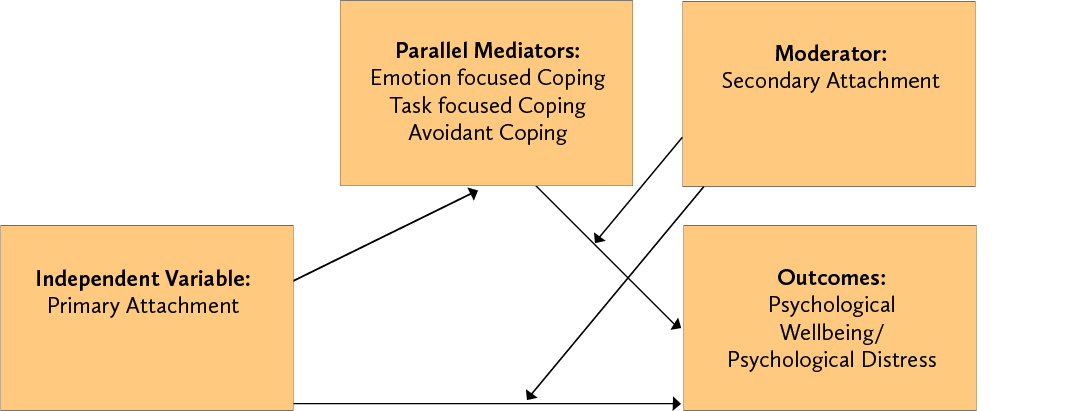Background
Adolescents’ wellbeing has become a global mental health concern due to the increase in mental health symptoms such as anxiety and depressive symptoms in this developmental stage (Camilletti, 2018). It is expected that research into protective factors such as attachment, coping and wellbeing will help inform our understanding of these mental health challenges (Camilletti, 2018). Additionally, cultural dimensions of individualism versus collectivism could influence adolescent development and mental health. For instance, the emphasis on autonomy in individualistic cultures encourages more focus on individual goals (Yeh et al., 2006); while in collectivist cultures the emphasis of interdependence promotes more connectedness with others (Albert et al., 2007), suggesting scrutiny of cultural differences to develop preventive and intervention strategies that could be tailored to use with adolescents from varied cultural backgrounds (Li et al., 2014; Malti et al., 2016). Thus far, 90% of the world adolescent population live in low- and middle- income countries such as South Asian countries however, reliable data for this developmental age group from these countries are scarce (The Global Burden of Disease, 2017). Noticeably, while adolescents make up 38% of the Pakistani population, the relevant mental health research is scant (Khalid et al., 2018; Qidwai et al., 2010).
Within the framework of attachment theory, secure attachment to parents (primary attachment) has been considered to form the basis for the child’s evaluation of self and others in terms of trust and being worthy of love and care, with positive mental health outcomes (Ainsworth, 1989). Attachment research also indicates that in adolescence individuals are more likely to direct their attachment needs towards secondary attachment figures, suggesting the importance of secondary attachment in this developmental stage (Aikins et al., 2009). However, the role of secondary attachment is under-explored. Further, attachment figures’ responsiveness and sensitivity in the time of distress help a child develop a sense of self-capacity and thus securely attached individuals are more likely to engage in adaptive coping (Chakroborty & Benerjee, 2017). By contrast, individuals with insecure attachment are more likely to perceive the world as unpredictable, and thus show more maladaptive coping (Wei et al., 2003). This, in turn, could augment experiencing more psychological distress and less psychological wellbeing (Guo et al., 2018).
The Current Study
This study investigated coping as a potential mediator of the link between primary attachment and psychological distress (depression and anxiety) and psychological wellbeing (autonomy, competence and relatedness), and examined whether this mediation is moderated by secondary attachment (see Fig 1). Three coping dimensions (task-focused coping, emotion-focused coping and avoidant coping) were considered as separate mediators to examine how each would contribute most to any mediation effects. Task-focused coping aims at encountering/resolving stressful situations and emotion-focused coping aims at using negative emotion strategies. Avoidance coping aims at changing the behaviour to avoid stress-related thinking and feelings. For moderation, two conditional effects were hypothesised: 1) Secondary attachment will moderate the direct effect of primary attachment on the outcomes respectively, 2) Secondary attachment will moderate the effect of mediator/s on the outcomes respectively. The cultural groups in this study (Pakistan and Scotland) not only differ in terms of cultural dimensions of collectivism versus individualism (Shah & Amjad, 2011), but also represent higher versus lower-middle income countries (World Bank List of Economics, 2018).

Figure 1: Diagrammatic presentation of the moderated mediation model
Method
A cross-sectional survey, using an identical test battery, was conducted with 12-18 years adolescents across two geographic sites in Pakistan and Scotland. In Pakistan, participants were recruited from three government schools in Rawalpindi. In Scotland, recruitment was carried out in three state schools in Edinburgh.
Questionnaires
- Two versions of the Experiences in Close Relationship Scale-12 (Wei, Russell, Mallinckrodt & Vogel, 2007) having same items but different instructions were administered to measure primary attachment and secondary attachment respectively
- Coping Inventory for Stressful Situations-21 (Endler & Parker, 1990) was used to measure coping strategies in adolescents.
- Hospital Anxiety and Depression Scale (Zigmond & Snaith, 1993) was used to measure psychological distress.
- Three subscales of Ryff`s Psychological Wellbeing Scale (1989) were administered to measure psychological wellbeing.
Analyses:
The data were analysed using moderated mediation modelling for each sample separately. Two models were tested for the outcome variables: psychological wellbeing and psychological distress respectively in each sample. The Pakistani sample comprised of 510 adolescents (51.5% male) with mean age 14.5 (SD = 1.57). The Scottish sample comprised of 610 adolescents (53.6% male), with mean age = 13.97 (SD = 1.56). Most of the Pakistani adolescents self-identified as Muslim and from Punjabi ethnicity, while the majority of the Scottish adolescents did not identify with any religion and self-identified as White Scottish.
Results and Discussion
Cultural similarities
- Secondary attachment moderated the relationship between primary attachment and psychological wellbeing in both samples, which suggests that even though insecure primary attachment contributes to reduced psychological wellbeing, secure secondary attachment may lower the intensity of this relationship.
- Secondary attachment insecurity had a significant positive effect on psychological distress across both samples, which suggests that insecure secondary attachment may act as an important risk factor for psychological distress.
- In both samples, primary attachment influenced psychological wellbeing both directly and indirectly via adaptive coping, reinforcing the universal role of secure attachment in enhancing wellbeing in adolescents through adaptive coping.
Cultural differences
- In the Pakistani sample, task-focused coping fully mediated the effects of primary attachment on psychological distress. This indicates the need of developing interventions targeting task-focused coping strategies in adolescents.
- In the Scottish sample, task-focused coping and emotion-focused coping partially mediated the relationship between primary attachment and psychological distress; avoidance-coping`s effect was non-significant. This suggests that the effect of primary attachment on psychological distress is more likely through emotion-focused coping and task-focused coping in the Scottish sample.
- Secondary attachment also moderated the relationship between emotion-focused coping and both psychological wellbeing and psychological distress in the Pakistani sample only. This suggests that enhancing adolescents` secondary attachment security may reduce the negative effect of emotion-focused coping on psychological wellbeing and its positive effect on psychological distress.
Limitations
As the current study was cross-sectional, future longitudinal studies will be needed to establish causal links between these variables. Data were collected from community populations; and as such, findings may not be directly applicable to clinical samples. The use of self-report measures may have introduced response-bias.
Conclusion
This is the first study to examine secondary attachment and mental health in adolescents with a meaningful representation of adolescents from both high-income and resource-restricted settings as well as individualistic versus collectivist societies.
Key implications for practice:
- Given the limitation of cross-sectional data, alongside primary attachment, it is probably also important to provide additional support for targeting adolescents` secondary attachment relationships, in order to enhance psychological wellbeing and lessen psychological distress.
- There appears from this cross-sectional data, to be some unique contributions of different coping dimensions towards psychological wellbeing and psychological distress in adolescents across diverse cultures. This suggests that different strategies to target different coping dimensions will be helpful to enhance wellbeing of adolescents in diverse communities.
Co-Authors
Dr Angus MacBeth: Senior Lecturer in Clinical Psychology, School of Health in Social Science, University of Edinburgh.
Professor Ethel Quayle: Professor of Forensic Clinical Psychology, COPINE Research, School of Health in Social Science, University of Edinburgh.
Dr Stella Chan: Reader in Clinical Psychology, School of Health in Social Science, University of Edinburgh.
All authors are affiliated with the Centre for Applied Developmental Psychology, School of Health in Social Science, University of Edinburgh.
References
- Aikins, J., Howes, C., & Hamilton, C. (2009). Attachment stability and the emergence of unresolved representations during adolescence. Attachment & Human Development, 11(5), 491–512.
- Ainsworth, M., D. (1989). Attachments beyond infancy. American Psychologist, 44(4), 709-715.
- Albert, I., Trommsdorff, G., & Mishra, R. (2007). Parenting and adolescent attachment in India and Germany. First publ. in: Perspectives and progress in contemporary cross-cultural psychology / Guanying Zheng … (eds.). Beijng: China Light Industry pp. 97-108. 97 – 108.
- Camilletti, E. (2018). Realizing an Enabling Environment for Adolescent Well-being: An inventory of laws and policies for adolescents in South Asia, UNICEF Office of Research – Innocenti, Florence.
- Chakroborty, A., & Banerjee, M. (2017). Assessment impact of mother, father and peer attachment on coping of young adolescents. International Journal of Indian Psychology, 4, (4).
- Endler, N. S., & Parker, J. D. A. (1990). Coping Inventory for Stressful Situations (CISS): Manual. Toronto, Canada: Multi-Health Systems.
- Guo, C., Tomson, G., Keller, C., & Söderqvist, F. (2018). Prevalence and correlates of positive mental health in Chinese adolescents. BMC Public Health, 18, 263.
- Khalid, A., Qadir, F., Chan, W., & Schwannauer, M. (2018). Adolescents’ mental health and well-being in developing countries: A cross-sectional survey from Pakistan. Journal of Mental health.
- Li, J. B., Delvecchio, E., Miconi, D., Salcuni, S., & Di-Riso, D. (2014). Parental attachment among Chinese, Italian, and Costa Rican adolescents: A cross-cultural study. Personality and Individual Differences, 71, 118–123.
- Malti, T., Noam, G., Beelmann, A., & Sommer, S. (2016). Toward dynamic adaptation of psychological interventions for child and adolescent development and mental health. Journal of Clinical Child & Adolescent Psychology.
- Qidwai, W., Ishaque, S., Shah, S., & Rahim, M. (2010). Adolescent lifestyle and behaviour: A survey from a developing country. PLoS ONE, 5(9).
- Ryff, C. D. (1989). Happiness is everything, or is it? Explorations on the meaning of psychological wellbeing. Journal of Personality and Social Psychology, 57(6), 1069-1081.
- Shah, M., & Amjad, S. (2011). Cultural diversity in Pakistan: National vs provincial mediterranean. Journal of Social Sciences (MJSS), 2, 331-344.
- The World Bank List of Economics. (2018). Retrieved from https://about.muse.jhu.edu/media/uploads/wdi2018.pdf
- The Global Burden of Disease Child and Adolescent Health Collaboration. (2017). Child and adolescent health from 1990 to 2015: findings from the global burden of diseases, injuries, and risk factors 2015 study. JAMA Pediatr.
- Wei, M., Heppner, P., & Mallinckrodt, B. (2003). Perceived Coping as a Mediator Between Attachment and Psychological Distress: A Structural Equation Modeling Approach. Journal of Counseling Psychology, 50(4), 438–447.
- Wei, M., Russell, D. W., Mallinckrodt, B., & Vogel, D. L. (2007). The Experiences in Close Relationship Scale (ECR)-Short Form: Reliability, validity, and factor structure, Journal of Personality Assessment, 88(2), 187–204.
- Yeh, C. J., Arora, A. K., & Wu, K. A. (2006). A new theoretical model of collectivistic coping. In P. T. P. Wong & L. C. J. Wong (Eds.), Handbook of multicultural perspectives on stress and coping (pp. 55–72). New York, NY: Springer.
- Zigmond, A. S., & Snaith, R. P. (1983). The Hospital Anxiety and Depression Scale. Acta Psychiatrica Scandinavia, 67, 361–370.



Discussion
This is an amazing blog.
Many thanks Amna!
Aspects highlighted are very pertinent in present day environment keeping in view the increased number of mental health problems. GOOD JOB
Sonia good work indeed !!!!! I hope to carry out a similar study in Malawi
Many thanks Action Amos for the comment! I am glad that you find my blog helpful. The original paper will be published soon which will further help you design your study. Feel free to contact me if you need my help!😊
Highly interesting. Please can you let me know when and where the original paper is published so I might obtain a copy? Many thanks! I am working abroad and give seminars and training on attachment and trauma, so any research, especially on older children and adults is always eagerly received.
Many thanks Tatjana for your comment and showing interest in this study! The original article will be available soon, I will share the link with the ACAMH which they may like to add to this blog post.
For your interest in adults mental health, recently I did a study titled: Primary attachment, secondary attachment, self-esteem and psychological distress in young adults: A Mediation model” and the manuscript for publication is in preparation.
Very interesting 👌
Great blog post indeed.
Interesting stuff to read. Keep it up.
Well designed study. Interesting findings!
Great blog!
Interesting read